The summer cottage should not be limited only to the garden and, in addition to practicality, he must also bring aesthetic pleasure. Flowers, alpine slides - make a real estate area from the usual estate, where they are pleased to spend time away from the city bustle, after a serious employment schedule. A beautiful garden or flowerbed is difficult to imagine without flower plants, one of the bright representatives of which is the collections. About how to plant and grow this shrub with your own hands, let's tell later.
Colon description
This flowering leafy shrub received its name thanks to the German botanic Richard Colvitz. In Europe, this plant was brought from Southeast Asia. The shrub is quite beautiful and unpretentious, so it can be grown in conditions of temperate climate. Beautiful dense flowering plant will become an excellent garden decoration. The genus of collections is presented with just one type - charming chalkxia.
Plant Characteristics:
- Collection is a beautiful shrub that blooms in the summer.
- In the fall, the shrub looks beautifully at the expense of colored leaves. The plant blooms very plentiful, small flowers, with a diameter of no more than 1.5 cm. They are collected into shibidal inflorescences, are located in pairs.
- Flowers Collection with pink color with a pearl tint, while there are so many inflorescences that the leaves and shoots are not visible through them. The blooming color is continuing for a few weeks, then the flowers fall out.
- Planted Collection gives the first flowers in about 5 years. At the same time, they do not fade, but fall on the peak of their flowering. This characteristic plant looks like Sakura.
- Fruits are formed on the place of flowers, which are seed boxes with non-resident seeds.
- In addition to the beautiful appearance, the blooming collection highlights a pleasant smell that fills the garden of summer freshness.
- Collivation bush grows multigulating. Every year he gives a very good root increase. New shoots first grow straight, and then arcuately deviate to the sides. The growing season of the plant continues from April to November.
- The most popular variety of plants is the pink-cloud challenge.
Choosing a place to land
- The collection is a light-affiliated plant, which is why when choosing a site for its landing it is necessary to give preference to well-lit places. A shrub can grow in the shade, however, in this case, it can be too pulled in height.
- Collection According to the reviews of gardeners is distinguished by its unpretentiousness. It grows on ordinary cultured garden soils. With a high groundwater occurrence, the presence of good drainage is a prerequisite. The most suitable for planting the collections are satechant soils with good fertility.
- When choosing a plot should take into account his relief. In the lowlands to plant this shrub should not. First, there may be stagnation of waist or rainwater, and, secondly, in the winter period there may be frosty air, which is also undesirable for the collections.
Collection: landing and care
Planting Collection
Planting a shrub is carried out in spring when the soil is already a good. Nothing difficult in the process of plating the collections no:
- First, it is necessary to prepare a hole with a depth and diameter of at least 50 cm. It is filled with a special mixture, which consists of 2 parts of the soil, 1 part of the sand and 2 parts of humus.
- Some gardeners are added to the landing mixture of mineral fertilizers, ashes or lime. Collection seedlings can be bought or grow independently.
- When landing a shrub, it is necessary to ensure it is enough space for development. The distance between the Kolvica bushes should be at least 1.5 meters. In cramped conditions, the plant develops quite slightly, rarely blooms, loses its decorativeness.
Crossclocation pruning
Strong trimming of this plant is not needed. On the contrary, it can only harm the normal development of the bush. The main trimming is reduced to the formation of the crown of the cult. At the same time, the side and top branches are not recommended. The rejuvenation of the bush is carried out after the end of its flowering.
Sanitary trimming is carried out at the beginning of spring. Its main task is to remove dead escapes.
Watering, feeding and mulching of the soil of harvest
Plant care rules:
- Watering during the cultivation of the collections is required regular (1-2 times a week), despite the fact that it is quite well tolerates dry weather. Each bush requires at least 10 liters of water. Watering soils spend only in the evening. In this case, the plant will receive and absorb more moisture. It is strictly forbidden to water the bushes in the daily heat.
- Collection grows perfectly with minimal feeders. Usually spend them during flowering when the plant needs maximum nutrients. This uses organic fertilizers (humid, cowhide solution). If necessary, if the development of the plant slows down, the solution of superphosphate is introduced.
- In total, it is possible to carry up to 3 feeding. The fertilizer must be neat. Excessive feeding can provoke a rapid growth of the plant, which will negatively affect his flowering. Publivic to fertilizers is very bad to carry cold, which can affect wintering. That is why the lack of feeding is much more useful than its excess.
- Spring feeding is to make an infusion of a cowboy in proportion: 1 kg of fertilizer for 10 liters of water. For one bush, 5 liters of infusion are quite enough. In the period before flowing, a solution of double superphosphate is introduced per 30-50 g of substance by 10 liters of water. For one bush use a whole bucket of the solution.
- Mulching of the soil is one of the main activities for caring for the collections. The process of mulching consists in the shelter of the nearby circle with material that has a low density. It can be straw, sawdust, chips, peat, leaves, dry grass, etc. Due to this, moisture remains longer in the soil and the activity of the growth of weeds is reduced. Annual weeds often do not even germinate from under mulch, which greatly simplifies the process of care of the shrub. Conduct it twice a year. The first is in the late spring, and the last one is in front of wintering. Mulching is carried out using peat, straw, crushed bark or wooden chips. The spring procedure begins as soon as the earth will eat enough from the module, but it will not be too dry. If you pour a mulch to the overwhelmed soil, the process of rotting may begin, which will cause the disease of the cooler bush. Mulch must be poured in the form of a torus (similar to the usual "donut"). In the center around the shoots should be a deepening. It will not give rise to the apparent roots, and will also allow to avoid damage to rodents. When using straw or sawdust, it is necessary to fertilize the soil with nitrogen, as they pull out this element from the soil. To do this, the mulch is added by humus. The thickness of the material layer must be approximately 5-6 cm. Less do it makes no sense. The moisture will still evaporate, and the material itself can blow away the strong wind. Winter mulching is well protecting the roots of the shrub from severe frosts. After the snow, the winter mulch is cleaned, give the earth to dry and put the spring layer.
- The plant moves a very well transplant, so when the new place is correct, the operation passes for the collection of unnoticed.
Zimovka Zolivia
The frost resistance of the collection is quite good, so wintering for it does not represent a special problem. The basis for the successful passage of frosts for this plant is the right choice of landing site. So, the collection should not be on the draft, otherwise the strong cold winds can cause frostbite to escapes and their die away. You still need to take care of good drainage, otherwise excessive moisture will lead to frostbite roots.
After the end of flowering, it is not recommended to carry out the poles. Otherwise, the winter hardiness of the plant decreases markedly.
Before wintering, the root circle is mulched. Do it in order to reduce the evaporation of moisture and heat from the roots of the plant. The area of \u200b\u200bthe plot covered with mulch must exceed the size of the plant crown. Mulching is carried out with the help of foliage, peat, compost based on sawdust. The thickness of the layer should be at least 5-10 cm. Under such a thick layer of mulch, the ground practically does not freeze.
Young collections require additional protection in the winter. They can be covered with tissue, paper, nonwoven material. Also, annual shrubs can be protected using snow. Before the beginning of winter, young shoots of the plant pressed to the ground, fixed and covered with the leaves of the lapse. With the loss of snow, it is thrown into a bush with a layer of up to 30 cm. It will ensure reliable protection of the plant from harsh frosts. Separate shoots only when constant warm weather is installed on the street.
The reproduction of collections
Collection reproduction is carried out in several ways:
- Seeds.
- Cuttings (both green and apparent).
- Digging.
- Division.
Cultivation of seeds It is rare, since it grows in this case for a very long time and gives average results. Usually sowing is carried out for the winter. Before the spring sowing is desirable to conduct a cold stratification procedure in wet sand for 8-12 weeks.
Green cuttings Breakdown is also quite rare, it applies to regions with severe winters. Plant them in summer. The winter hardiness of the harness from green cuttings is quite low. They often freeze even under the shelter.
Warm cuttings are harvested for the winter, and spring plant. Cuttings cut off the strongest shoots. Do it a very sharp knife so as not to damage the bark near the cut. The cuttings are then installed in a container with water or nutrient solution for rooting. After rooting, they can be planted for a special bed, where they can be overwhelmed under the shelter. The next summer, seedlings can be transferred to a permanent place.
Reproduction with grains for collections - The most common way that gives the best results.Challenges are chosen from the strongest shoots. Next to the maternal bush, a small ditch is digging, lowered the grooves in it, fixed and reproduced with soil. The rooting place is constantly plenty of water. After the apparent roots are good, you can cut off the maternal bush, and the resulting seedling to transplant to a permanent place or to a greenhouse.
Bust division Split Collection during a transplantation. The dried bush carefully examines. When damaged, or rotten roots need to be deleted. Then the bush is divided into the required number of bushes, provided that each of them should have developed roots and powerful shoots. The location of the cut must be treated with therapy coal. Landing the decene is produced by the same scheme as conventional bushes.
The highest quality planting material is obtained from the taps and the weird cuttings.
Diseases and pests of collections
Collection shrub is quite resistant to various diseases and impact of pests.
Among diseases are most often affected by culture fungal diseases, viruses.
The cause of fungal diseases is most often incorrect irrigated or poor soil drainage. They are manifested by brown or gray spots on the leaves of the plant. The fight against fungi is carried out using the soil processing by fungicides. Viral diseases are not amenable to treatment, so the affected bushes are simply removed and burned.
From the pests most of all create:
- Humid Wheat. Prefers to destroy young shoots, braking the plant development.
- Shield. Spring to the crust of the plant and sucks juice. A large number of shields can lead to the destruction of the bush.
- Caterpillars Prefer the leaves of challenge. They cannot harm the bush, but significantly spoil his decorativeness.
The struggle with pests is carried out by spraying the bush insecticides.
Using Pollition Planting in Landscape Design
As a rule, the spanking shrubs are used in landscape design as a dominant plant. Thanks to its abundant and fantastic blossom blossom, the bustviation bushes look harmoniously both alone and surrounded by other plants. Lonely growing shrub in the "sea" of well-groomed emerald lawn will leave an indelible impression by its beauty. It looks great for the collections on flowerbeds with peonies, irises.
Often together with other blooming shrubs, the collections are planted along the hedge. Excellent shrub neighbors can be Waigela, Deniya, etc.
Group landing of several bushes of Colxia Maradko look very beautiful. Their abundant flowering form real clouds of gentle pink color. On their background, the blue landing of Gerania Himalayan, blue Sienii is perfectly distinguished. Near the shrub can be planted to plant an excellent silver-white carpet. It will become an excellent background for color bloom. In a pair, Robinia, Japanese Spiray, Padoliste Magonia, look at her very harmoniously.

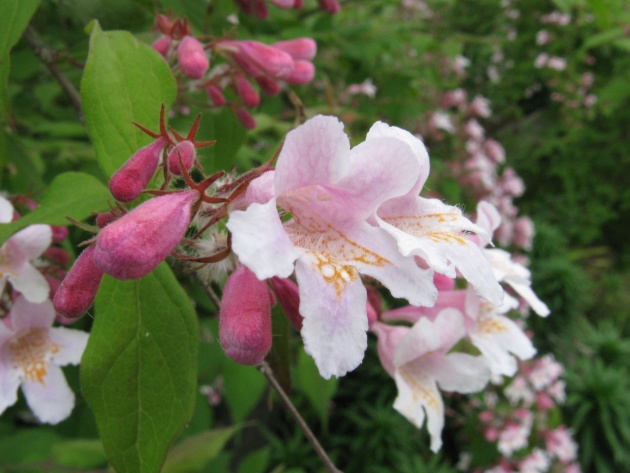
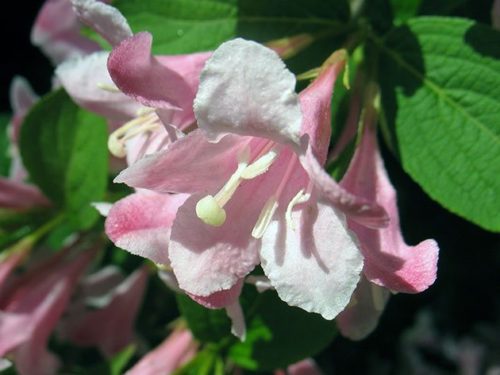
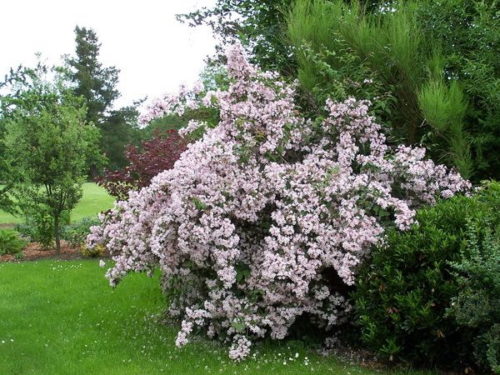
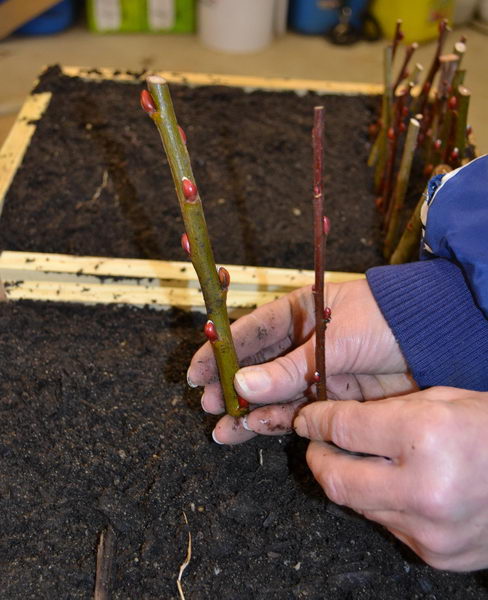

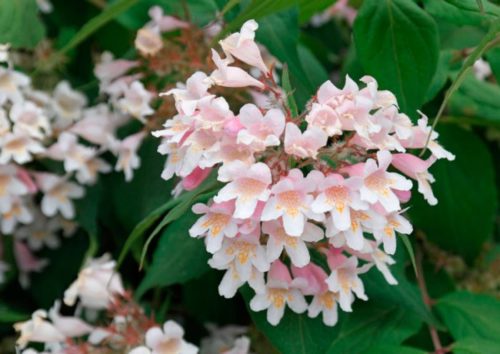
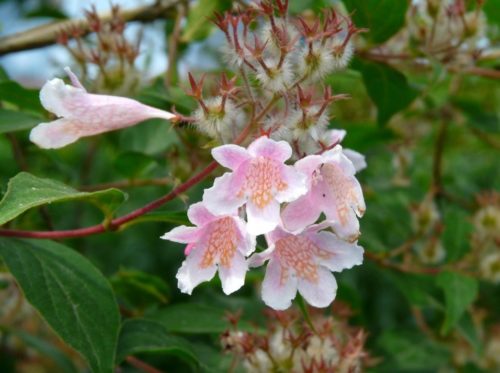
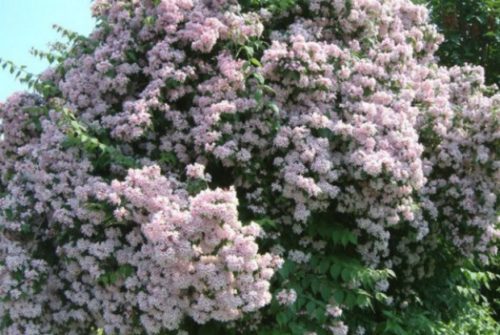
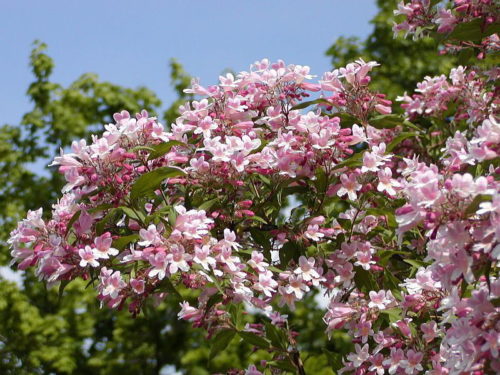
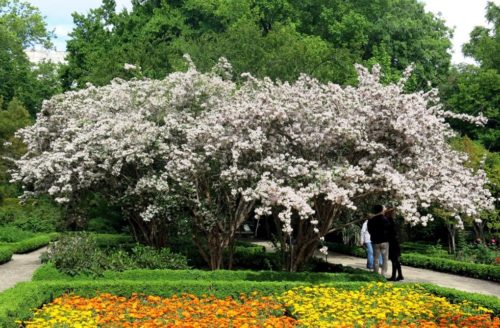
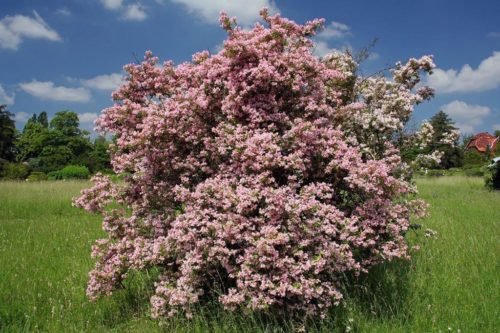
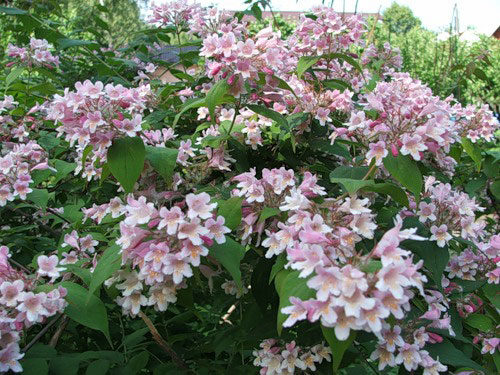













 Start a discussion ...
Start a discussion ...